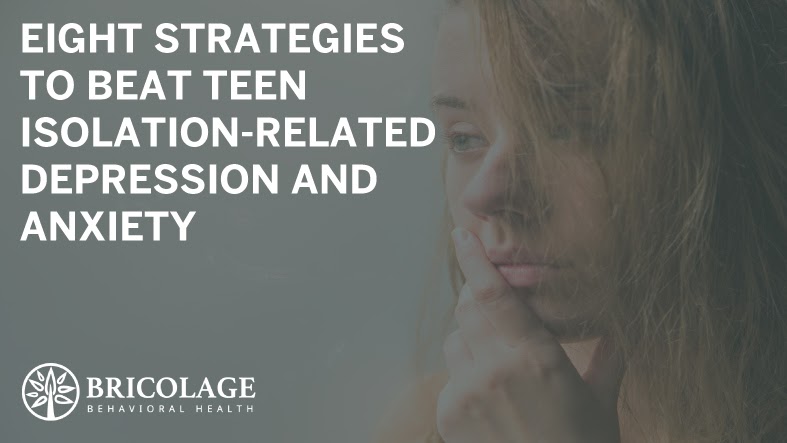It’s been a very long time now that pandemic news has dominated the headlines. First, we went through a phase of some mysterious virus in Asia to the news it had been found right here in the United States. Then we heard it’s similar to the flu, and then we heard detailed stories about people were dying alone because families couldn’t visit for fear of spreading the virus.
Americans and families hunkered down for the most part in a sit-and-wait-to-pass period of self-isolation — unless you were considered an essential worker. As some places began to reopen, parents were faced with the dilemma of the school still being closed and having to make hard decisions about jobs because their children were home full-time and isolated from their peers and extended family.
For kids who were impacted more directly with a personal situation with COVID-19, they may have felt anxiety and worry during this time of increased distance.
Remember when you were a teenager and a year seemed to drag on forever due to your limited number of them? As you age, “the years start flying by” is a much more understood idiom. You have so many more memories pre-COVID-19 to draw from than a 14-year-old does who just wants to see their friends again and go roller skating, or the mall, or ANYWHERE!
Piling on top of this long, stressful time, many have questioned “what is this social isolation doing to our kids?”

Many 2020 high school graduates never got to walk the aisle to “Pomp and Circumstance.” Diplomas were mailed or picked up individually at school. Communities began to rally with creative solutions such as bus deliveries curbside escorted by caravans of first responders.
A 16-year-old seeking their first job for spending money or saving for college was out of luck unless they worked at a grocery store or other alternative. For those lucky ones, their parents struggled with concerns they were putting their child at risk, or how it would impact another family member with secondary medical issues, or aging grandparents.
Driving tests were delayed. This opportunity to gain some newfound independence was another sacrifice made to restrictions. Once they were lifted, the desire for many children had simply gone away, leaving many parents scratching their heads. This lack of interest is common when a child stops challenging why they can’t do things and just responds with indifference once the opportunity presents itself again. But just because no longer caring is common doesn’t mean healthy; it can be a coping mechanism.
Sporting activities, theater productions, and other extracurricular activities are ways for kids to grow confidence, explore new interests, grow skills, develop socially, meet new people, get exercise, boost moods, and keep positive mindsets.
Begging for sleepovers was common. The narrative goes something like this in many homes:
15-year old: “But Gabby’s family doesn’t let anyone come over, so we’re not at risk.”
Parent: “Didn’t I just see Gabby at Albertson’s when I picked up our groceries? She was with a few friends.”
15-year-old: Looks at you and a tear rolls down her face. She quietly goes to her room and doesn’t come out for three days, except when you’re not around, to get food.
Parent: You choose to not speak with your partner about the school email notifying you her grades are slipping. You don’t want to upset your daughter further.
Or this:
17-year-old: “Mom, I was at the park shooting baskets with John and invited him over.”
Mom: “Isn’t John’s brother home from college because he tested positive?”
17-year-old: “Yeah, but his brother doesn’t leave his room.”
Mom: “I thought they only have one bathroom?”
17-year-old: “Mom, why do you have to be so strict. I’m going crazy around here!” Door slams. Hard.
Kids are resilient, yes. But teens are just learning about their identities and how they want to approach the world. How much can they take being told “no” and remaining isolated before they develop cracks in their mental armor? Social isolation leads to loneliness and loneliness often leads to depression and anxiety.
Behavioral symptoms common as a result of social isolation
- Mood swings
- Crying
- Panic attacks
- Lethargy
- Anger
- Substance use
- Lack of hygiene
- Slipping grades
- Poor diet
- Messy, cluttered, dirty personal space

Research Studies Confirm Increased Loneliness Among Isolated Teens
Since March 2020, there have been many medical concerns expressed and some benchmark studies along the way measuring teens’ mental health due to isolation requirements, whether mandated by the government or set forth as a household.
The Making Caring Common Project, an initiative led by the Harvard Graduate School of Education, released a study in February 2021 showing young adults may have been hit the hardest by the pandemic. It’s considered preliminary data due to the limitations of only 950 participants, but it is noteworthy that 67% of young adults said they experienced “serious loneliness.” Several other studies have supported these findings, including the Centers for Disease Control and Prevention (CDC).
“I was surprised at the degree of loneliness among young people,” said Richard Weissbourd. He is a psychologist and senior lecturer at the Harvard Graduate School of Education and helped lead the research. “It’s a group that we are really concerned about.”
Start With Professional Counseling
If these symptoms and concerns are present but not spoken about in your home, now is the time to press restart on a new chapter with a focus on mental health. If you are noticing the symptoms above in your child, start with a referral from their primary doctor for a therapist trained in children’s mental health treatment.
While you’re the parent, you are probably not best equipped to be your child’s counselor. It crosses ethical lines and doesn’t allow for open discussion. Your teen can be helped by sharing with someone who is not an authority role in their life. Their counselor should be trained in different therapy methods designed to work with your teen and teach them to advocate for themselves with increased communication.
Sharing how they are feeling, finding appropriate outlets, considering other perspectives, and developing a plan for overall wellness are just some of these tools they can acquire through counseling.
While developing an individual connection between therapist and patient is often the best one-on-one, in-person, this may not be an option for some people. In those situations, some locations may provide telehealth. These virtual appointments are held through a secure server and conducted on a mobile device, tablet, or computer.
There may be a set schedule of meetings arranged after the initial session, both separately and together. Separate sessions encourage your teen to open up to someone. Your role can be a supporter for helping your teen get to the session or log in on time. As a parent, you may be called in from time to time, but the sessions are mostly done privately.
Family inclusiveness is important but let the therapist dictate the terms of their practice. You will be notified if there is a life-threatening concern, but probably won’t hear many details from the therapist on what is shared otherwise. As far as your teen, you can let them know they can share if they want, but you are respecting their privacy. This can be a strongly needed boost in their self-esteem and positive growth path.
In addition to scheduling therapy, read on for ways you can reach your teen on the home front. Think about your teen’s specific interests and communication patterns. Having a plan will help give you direction to be the support they need daily.

Eight Strategies To Not Let Isolation Get You Down
Here are eight strategies to help your teen see beyond the idea of isolation and seek new ways to achieve their goals and keep mindful of their mental health.
 Speak Openly About the Importance of Mental Health
Speak Openly About the Importance of Mental Health
Model healthy behavior. You most likely know this already, but it is hard to remember sometimes. Maybe when your daughter fell as a child, you knew she would turn to you to see what cues you offered and react accordingly. If you smiled and picked her up, she was more responsive in a positive way than if you frowned, rushed to her, and yelled “oh, no!” and she would respond by crying.
Your tone and mood can affect the whole house. Opening curtains allow sunlight to enter and brightens their morning. Keeping a routine — even if somewhat relaxed — keeps them centered. Maintaining normalcy in all other avenues can show them one area — enforced isolation requirements — doesn’t have to derail everything else.
As this period passes, there will be many new events in their lives. While some are positive, some will be negative. Learning coping skills now will keep them on track down the way.
 Create a New Family Routine
Create a New Family Routine
Maybe Sunday afternoons become a time to reconnect before the week’s demands. Many families have gotten tired of the electronics routine and adopted old-school games and puzzle time. Seeing multiple generations share time together is helpful for a teen, versus sitting alone all the time lost in focus with their inner thoughts. You don’t need to create a fight if they choose to sit out. Let them join at their own pace. They may hear the laughter and be curious about what they are missing.
Celebrate This Special Time
Don’t ignore the elephant in the room, but also celebrate the benefits of the temporary “new normal.” Brainstorm over a dinner discussion or another random gathering and play a game about the benefits. This is a way to demonstrate turning from negative thoughts and embracing positive ones. The mood can change dramatically.
You can start by pointing out a few:
- wear pajamas all day
- be able to sleep in without the dreaded morning bus rush
- spend special time with dad or grandma
- sleep in tents in the backyard on a school night
- learn about mom's job
- see their teacher's living room before the school building reopened
- feel connected experiencing something historic happening to the entire Earth at once that they will always remember
Motivate and Encourage Rather Than Punish and Nag
Your teen is old enough to realize what needs to be done but hasn't mastered managing their emotions. That's a hard one for many adults! As they work through feelings with their therapist, you can reinforce a positive approach from the home front.
Think to motivate or encourage rather than along the lines of punishing or nagging. This is personal to each family's dynamics. For example, it could be a promise to let them have the house alone for a while, while everyone else takes a drive. They need some space and their room isn't always cutting it. You just might come home to a clean house or a showered kid!
 Encourage Connections With Cautions
Encourage Connections With Cautions
On a nice weather day, your teen could meet a friend for a social distance park outing or hang out in the backyard. If you hear them laughing on the phone suggest a get-together with hand sanitizer, masks, and distanced seating. This might go a long way toward them understanding you when you have to say no to a late-night party at “somebody’s” house or driving in cars together if that’s your family’s rule.
 Practice Mindfulness With Screen Time
Practice Mindfulness With Screen Time
Screen times can be mindfully brought up as a whole family. Around lunchtime, do a spot check and ask everyone to admit to their usage level without fear of punishment. Maybe the loser has to do the after-dinner dishes — in good fun. Gently pointing out that a third of the day has passed can get people internalizing your points in a good way and of being more aware of what they need to be focused on the rest of the day.
 Encourage Food Exploration, Exercise
Encourage Food Exploration, Exercise
Feeling good truly is a whole-body approach. If your teen’s diet is out of control with junk or barely stimulated by their favorite foods, encourage food exploration. Maybe focus on different cuisines and have a weekly theme night. Cooking together is a great way to bond and develop kitchen skills so when they eventually spread their wings in their own living space, they can make something beyond heating frozen taquitos in the microwave.
Same thing with exercise. Maybe you're not flying to a fancy resort or hitting Las Vegas anytime soon, but trekking to national parks can still be managed during busy times, with off-the-beaten-path trails and earlier or later start times.
 Make a Mood Board
Make a Mood Board
Get crafty and visit the office supply aisle for some poster board. Bright colors can boost spirits, and who doesn’t love new markers, pens, and glue sticks? You can ask around for old magazines, print pictures off your phones, or test your art skills by drawing or painting.
Encourage your teen to invite their friends over to the backyard, front sidewalk, or meet at a park with blankets and their own supplies, while you provide the boards. There are no rules when it comes to mood boards. They are thoughtful ways to have a calming, often inspiring, fun activity to display and remember. If they get old, switch them out for new ones, but be sure to take pictures to capture the old ones and print them in a smaller form. They’ll be great memory keepsakes.
A simple internet search will provide you a larger arena of resources, including some from the National Alliance on Mental Illness, to connect with your teen at a level you know they respond to best.

Innovative Mental Health Care for Children and Adolescents
Bricolage Behavioral Health, based in Flower Mound, Texas, provides evidence-based care for adolescents, including family integration and academic support for patients ages 8-17 in the Northern Dallas/Ft. Worth area.
Our supportive mental health services are available when you need it most, and our commitment to providing high-quality care has never been more important. We have innovative care with your health in mind! Connect with us at 469-968-5700.
FAQs:
- How much time should I let my kid out of isolation?
Family rules are for families to make together. Mental health professionals suggest if your teen is not under quarantine or isolation for COVID-19, they can continue normal activities with precautions.
If your teen has anxiety about being around people and getting sick themselves or spreading the illness to others, you can act as an advocate for them by calling ahead to learn how the environments have taken proper precautions, such as work or school. It can be hard for a teen to speak up in an environment if they see unsafe measures. Remain vigilant and compliant with local health departments and the Centers for Disease Control and Prevention (CDC).
Follow mask guidelines, sanitize hands, and avoid crowded indoor spaces where it is impossible to maintain social distance guidelines. Activities like bounce houses or other indoor play activities should be avoided. If they had to isolate due to COVID-19 concerns, seek advice from your medical doctor or the local health department on isolation compliance.
- How does isolation affect children’s mental health?
Isolation can increase a child’s loneliness and anxiety, which, if left unchecked, could develop into depression. It is important to understand this and be proactive in keeping connections rather than digging out to rebuild from depression. Finding strategies around isolation, like setting scheduled times for face-time with grandparents, cousins, and other extended family members who they are unable to visit can give them things to look forward to.
- Should children interact with people who are at increased risk of COVID-19?
As the vaccine rollouts continue, people should proceed with caution and continue to take precautions they have learned in the past year. Children can pass the virus, just like others, while showing no symptoms. Encourage phone, video, or socially distanced gatherings in the meanwhile.





